
Wheels are turning again!

April 24th, 2008, all of a sudden
With the end of steam in
Nine years after we started the negotiations with Myanmar Railways, the state railway project came to fruition, finally. We would be able to haul authentic looking trains with steam over the main line between Bago and Pyuntaza and on the line to Mottama. It was a long, rocky and also very expensive way we’d had to go down. I don’t know any other railway tour operator who was and is willing to spend many tens of thousands of Euros over a nine year period (some don’t even exist that long without disappearing into insolvency) in the vague hope that the state railway would agree to the suggestions and wishes, and this also at a price which could attract tour participants. In addition it was not sure at all that such a tour would sell because it was clear that it wouldn’t be a cheapy. At the beginning of the negotiations, it didn’t look promising at all. Instead, it seemed it might not be possible at all, and even if so, not at an affordable price. In the tour reports from our 2008 and 2009 tours, I wrote about the beginning of talks with the state railway up until the negotiations stalled, and about the little hope we had left:
“We’re still talking with the people in charge about charter steam trains, but it’s difficult when the ministry is strictly against it, or only at a price which is beyond all reason. However, it seems not everything is lost. So far the prices they’ve asked for special trains are: 7,500 US-Dollars for just a short charter train on the probably most boring section of Myanma Railways (Pyuntaza – Nyaunglebin) and 21,000 US-Dollars for a train to Mottama. Just imagine: a group of 20 people would need to pay 1,050 US-Dollars each for just one single train. This would fill a lonely day. 7 days charter trains and you needed to pay some 5 to 7,000 US-Dollars per person without flight, hotels, bus, guide, food etc. Obviously impossible.
While in
Another reason to say no to these crazy prices was that they allowed only 5 freight cars per charter train. This reason sounds like a Chinese excuse: the locos are old and can’t haul heavy trains any more. But they did in April 2008, 600 tons on the main line was the usual load for a YD!
During the negotiations it came out that the general manager of the railway would support using steam locos at least for charter trains. The resistance came from the ministry. The GM even doesn’t like to talk to the ministry, not even on the phone! Some tensions I would say … besides the ministry of transport we also contacted the ministry of tourism, but their position is not the strongest after tourism came down by 75%, according to official sources, and 90% according to what we have seen on our trip. They support the idea of steam charter trains, but he can’t do anything about
During further negotiations, the general manager of the railways agreed to let us buy our own fuel and our own water to serve the locomotives for charter trains. This was a first step towards bringing the prices down, even if you had to arrange the fire brigade and oil tank trucks at the depots.
I was trying to get a permit to haul regular trains with steam on the Myanmar Railways because a five freight cars long train is neither really photogenic nor authentic, but to haul passenger trains, as we had in 2007, seemed to be impossible by now. Even the 85/86 carries no grey/black coaches any more, only the new brown ones. But there is still a great opportunity for authentic – real – freight trains. But time is running out. It’s not only about the steam locomotives,
A local businessman who earned his money in the tourism business wanted to run steam charter trains around Bagan. He was able to convince the state railway to overhaul a steam locomotive. The state railway picked YD 967, which received its last overhaul in 2006 – some year and a half before they finally extinguished the fires in their locos. After they’d made it serviceable again, with very little effort, they rented the loco to the businessman.
YD 967 awaits tourists in Bagan - which didn't show up.

With the price for a balloon flight over Bagan in mind – well above 300 Dollars – they set the ticket price at something between 100 and 160 US-Dollars. But at that price they couldn’t find sufficient tourists to fill a train. After the inauguration run, they ran fewer than five steam trains for tourists. Despite this the state railway thought the tourism business would need some more time before it became profitable. Now they wanted to overhaul two YDs and two YCs. But the marketing was lousy and the prices were high, so the businessman cancelled his contract with the state railway before it expired.
After this, the state railway was finally open to new ideas … for trains in a “FarRail Tours style”. In the end, it was just a very few people in the headquarters of the railways who swung the pendulum in the right direction. The Deputy General Manager (Locomotives) is a diesel man, as he states himself; he needed to believe what he was told about steam locomotives. And the people from Bagan told him that the steam locos could only make it for five, in the best case for ten, kilometres under their own steam with a maximum of five wagons. The people who operate the locomotives in Bagan were happy to repeat this fairytale as long as it had to be accepted as a given fact. Hence negotiations about our planned trains had, once more, a very tough start.
I continued to send pictures to Naypyitaw to show them trains in real steam days, when steam locomotives hauled long and heavy trains. But they came back with the fact that they’d reduced the boiler pressure from 180 to 140 psi and that’s why a steam locomotive can’t haul more than 5 wagons over no more than ten kilometres. But when would it need its highest power output? Only when it comes to its highest permitted speed! And where in
When we finally received the okay to run steam hauled charter trains, much time had passed and almost all four wheel freight wagons were out of use. At least, the required rolling stock to form an authentic stone train wasn’t available any more. The traditional grey/black passenger coaches were all repainted in blue-brown, cream-brown or with a full advert label over the complete body of the coach. The triangles to turn locomotives in Pyuntaza and Mottama were not serviceable any more, as well as the turntables in Bago and Mokepalin (Mokpalin). The water supply was another problem; due to the long time without use, all water supply facilities were dead. And finally, with every solution we put on the table, the railways came up with a new problem.
Only a shadow of steam ...

Especially, the wagon problem cost a lot of time and persuading skills, and of course money. The railways gave us permission to visit large freight yards and their workshop to find appropriate wagons, but they didn’t allow us to take photographs there. Hence, we had to write down every wagon number plus the location and condition of the wagon. As we handed over the list of wagons we wanted they came back – after several weeks – with a different list of wagons. It took many months before we could agree to a list of wagons which were appropriate for our purposes. But after just three months, they informed us that there were changes necessary; these and those are not working, we’re now offering the following wagons … wagons we didn’t need and didn’t want. So we took again some money and asked them to overhaul the necessary wagons and re-paint appropriate passenger coaches. The passenger coaches didn’t only receive a new paint coat, they also overhauled them completely.

Instead of the planned two passenger coaches, we had in the end, four plus one brake van, all in traditional grey/black. This allowed us to offer an authentic passenger train instead of a mixed only.
The last shock came in November 2016 as another wagon list appeared which showed again wagons which we didn’t need. A traditional stone train wasn’t possible with these wagons. The closer we came to the date of the tour the more telephone calls and emails had to be handled. Finally, our guide flew to
YC 629 left the workshop as a coal fired locomotive. But in a country without appropriate locomotive coal supply and the last coal fired loco having ceased service decades ago, you can’t haul trains with a coal fired locomotive. The skills of how to operate a coal fired loco had been lost, after so many years. So we couldn’t use this loco for our purposes. On the other hand, we really wanted to use a 4-6-2 Pacific. So we tried to get permission to convert the loco back to an oil-burner, as it had been for decades. We persuaded them to do this for us. We paid the money and they really did it! In September 2016 the loco went back to the workshop at Insein and was converted in October/November to a traditional oil-burning locomotive. The test runs were successful. So we got one of the wonderful British Pacifics for our trains.

For the tourist trains, they had painted fancy embellishments on locos and tenders. As tourists would have asked to see a Disneyland loco! Tourists actually didn’t appear for the offered trains from Bagan. But we wanted to repaint the loco to offer authentic looking trains. We bought the paint and paid the railway employees from Bago, who would otherwise have waited idle for new tasks to be done, which didn’t exist. Despite the fact that we had arranged and paid for it, an official approached us and required a payment for the paint and the use of the employees. So we were to pay twice. Our local guide could reject this odd request, fortunately.
Before the tour started: final touch on YC 629; according to pictures I brought with me.

The railways clarified all issues of water supply in time. Sometimes, we needed the local fire brigade. Myanmar Railways also repaired the turntables in Bago and Mokepalin. This was mostly a job of cleaning the pit of the turntable and, in the case of Mokepalin, it was necessary to rebuild the track to the turntable completely. The triangle in Pyuntaza was completely overhauled. It hadn’t seen a locomotive turning on it for more than a decade. Even more work had to be done in Mottama, they rebuilt the triangle from scratch, using brand new sleepers.
Brand new triangle in Mottama, only built to turn our locomotive.

For our tour we had these locomotives available:
We used them all in front of different train compositions.
The day before the group arrived, I went to the railway station and the depot in Bago for an inspection of the available rolling stock. Despite my fears, everything was prepared neatly by the state railway. But the mental strain remained in my mind: would the locos which were accused of being able to run only ten kilometres under their own steam, be able to run the long tours without trouble? Will there be failures? Are the loco crews able to handle these engines after nine years?
So it was a good decision to start with the blessing of the locomotives. In a very religious society someone should do it if you’re facing a big challenge. The monks did a very serious job; the ceremony took more than two hours. After many supplications and wishes for the salvation of the locomotives the monks went into each cab and read Buddhist prayers. In the cabs the railwaymen placed candles on the cut off wheel, the vacuum brake and the water gauge. The locomotives were decorated with baskets with food and flowers, and one loco had a candle held in a rum bottle (Grand Royal) and placed on the buffer beam. The whole ceremony took place in track No.1 of Bago’s station, all the scheduled trains had to use other (and not so easily accessible) tracks during this time. Yeah, you must have priorities!
The blessing:

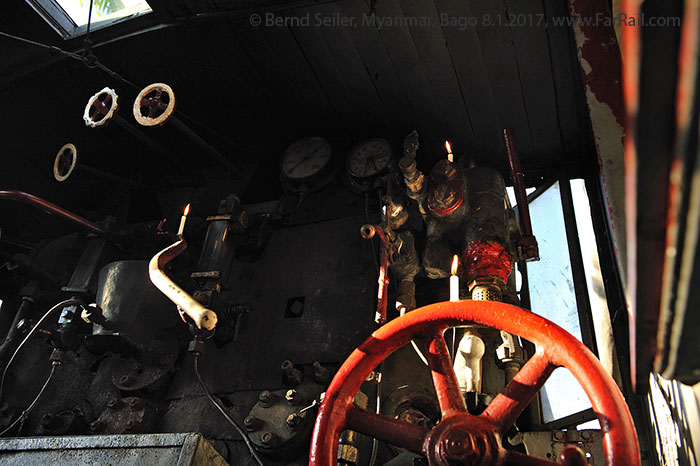
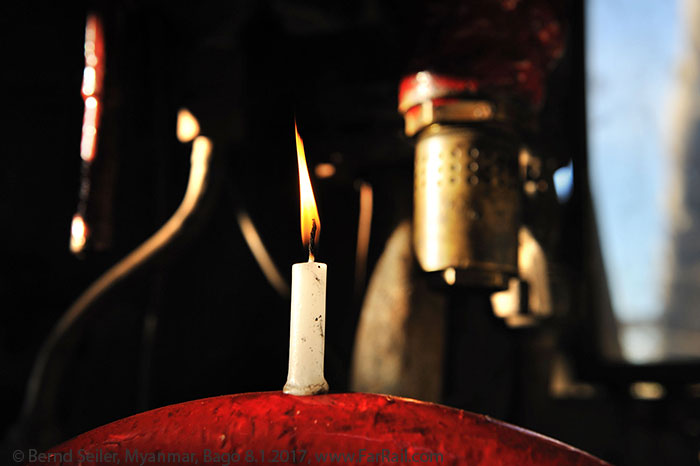


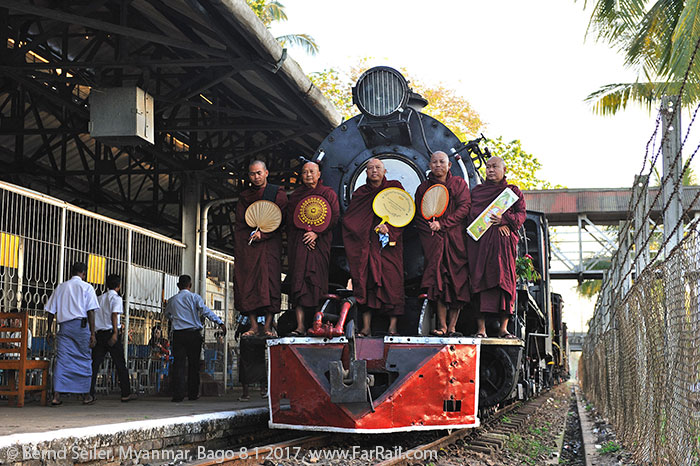
As we became aware of the blow of a steam whistle in the dark of the next morning, we knew that our locomotive had awoken after nine years, for its mission. The blessing had helped! Still in the dark of that morning, with a quietly roaring oil burner YC 692, sidled up to the train and touched the coupling gently. We had ordered a diesel helper for all the days – but as it quickly turned out, we didn’t need it except to save fuel and the transport of an oil bunker to feed our locomotives.



The completely overhauled passenger stock looked perfectly. We went half of the line to Pyuntaza without a diesel helper. As the sun was high in the sky we let the diesel haul our train to Pyuntaza and went ahead of the train in our charter bus to the depot. With the help of the diesel, the train wasn’t any faster because of the speed restriction of 20 miles per hour for trains without a through brake.
Our train to Pyuntaza


In Pyuntaza we saw all the locos which were collected there in spring 2008:
In Pyuntaza, we needed to turn our locomotive on the refurbished triangle. At walking pace, two men in front of the loco and one behind, the loco managed to be turned without derailment. With the help of a diesel pump and a hose they took water from a little pond. In warm afternoon light, we were able to do a departure shot from the station and on the line.
Taking water ifrom a little pond:


Pyuntaza southbound:


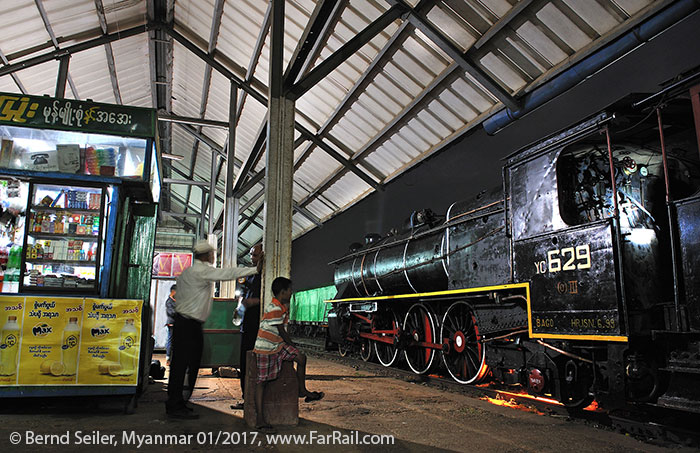
Our train reached Bago well after dusk and so we asked whether it would be thinkable to add a charter train to the programme, allowing us to take a picture of one of the master shots of the main line. This included the need to have two steam locos in steam because in the morning we wanted to haul the Nyuangkhashe mixed with YD 967 and then in the afternoon the passenger train with YC 692 from Payagyi. A charter train needs to be ordered at least a month in advance with Myanmar Railways, but after a call with the General Manager, they agreed to everything and let us have this additional train with one evening’s advance ordering.
Woman are waiting for the express to arrive while YD 967 needs to wait for the next morning to come.

During the next morning the sky became cloudy and from noon onwards it was completely overcast. But this didn’t stop our joy: both trains went ahead as scheduled and resulted in several nice pictures. As we had only one diesel loco as backup we could only attend one steam train with a diesel. Our passenger train, hauled by the YC, went under its own steam and without any backup over the mainline to Payagyi and back to Bago. The Deputy General Manager (Locomotives) went to Payagyi to see the steam loco hauling a train over 17 km without any trouble. Back to Bago the loco made 34 km with no diesel and proved that steam is still able to haul trains, even with reduced boiler pressure.
Nyaungkhashe mixed

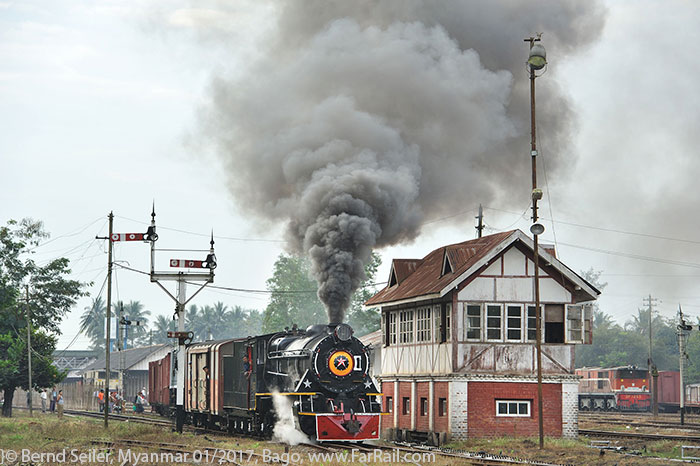
A fisherman, seen from the Bago bridge while walking to a photo position.

Walking on the rails ...

Old friends you meet ...


And this was our additional charter train:


On the third day, YD 964 had the honour of hauling a stone train to Zingyaik, as it had done until nine years ago. The further we went from Bago the more confident the crew became about the ability of a steam locomotive. In the end, they were going with no fear of a problem from station to station in short time slots between regular trains. They did this even after we had already sent the diesel three stations ahead of our train. The only problems our loco experienced were a warm bearing on the right hand connecting rod at the second axle, and a leaking regulator gland. Both issues were repaired on our rest day in Mottama. Our return run from Mottama to Bago went absolutely hassle free.
Our stone train to Zingyaik:










The rest day for crew and loco in Mottama:



An armoured railcar in the shed of Mottama:


The next day we started from Zingyaik:

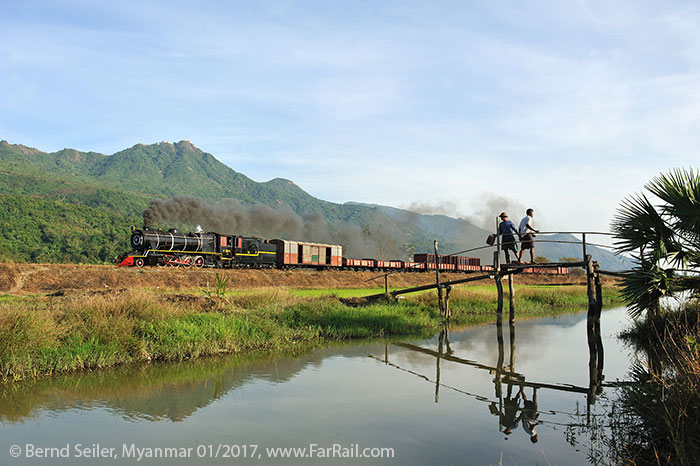











Without any problem and surprises the three locos performed on all our trains very well, after not having moved a train properly for more than nine years. The blessing of the locos must have been the key to this!
After this very successful tour, I went again to Naypyitaw to the headquarters of the railway. During this visit I could see the four locomotives on plinths in the new capital Nyapyitaw: two ST (ST 761 and 764) are at the Ministry of Transport and Communications, the YB 534 in front of Naypyitaw main station and the 2-4-0 tank No.A1 inside the station building.

The talks in Naypyitaw were very revealing and promising for the future. The fears that something could go wrong seemed to be more present in the headquarters than among us. They’d had to stretch some of their regulations widely to make our tour happen. But on all accounts they would be happy if we would turn up again. I need to go there again for sure because all the expenses in the preparation of the tour can’t be refinanced with a single tour – especially not when some of the money changers offered rates 3% below an equal rate between Euros to Dollars. Remember, some time ago the rate was 20, 30, yes, even more than 40% better for the Euro than now. This made things which had to be paid in US-Dollars in advance and then paid back in Euros later much more expensive, so any kind of calculations became obsolete over the years.
The state railway has a project to rebuild the main line Yangon –
We also talked about different projects to preserve the historical treasures of the railway and the opportunities to establish a railway museum in Bago. Myanmar Railways have a small museum in Naypyitaw, but it’s almost always closed. But who might come to Naypyitaw to visit this museum? Naypyitaw has neither culture nor entertainment to offer. It’s one of these faceless new towns straight from the drawing board. There is nothing worth a visit – except the four steam locos of course. Bago instead, after Yangon,
Only the marketing is an issue. The state railway lacks expertise in marketing. Over the last years, Myanmar Railways has been losing freight traffic and passenger at an alarming rate. Not long ago, even on the slowest passenger train, you couldn’t expect to find a seat. In 2017 we counted on the Mottama – Bago mixed No.86 in Hninpale, exactly three passengers. Those three passengers had the choice between three passenger coaches and one combined brake van/passenger coach. The train staff members outnumbered the passengers. Even in express trains you have a free choice of seats on the shadow side of the coach these days. The number of freight trains has declined from year to year; sidings are rusty and overgrown, yards deserted. This can’t go on for long, Myanmar Railways must act.
On the other hand roads have come to life. The daily traffic jam in
For the moment, the state railway has nothing to offer which can compete with the new development on the roads. It seems they’ll sleep through it. Marketing is invisible and the ancient structures of the railways don’t fit the new times. Many soldiers who left the army went to the state railway because it’s a state owned company. Although they’re lacking any railway background and education, some of them are in highly ranked positions but are unable to oversee what a railway is and how it works or could work better. The real railwaymen find it sometimes difficult to do what is necessary. Hence the railways are inflexible and don’t react to the changing world around them. They’ll lose more and more customers if they don’t change themselves right now. Currently, Japanese companies are involved in the development of Myanmar Railways, but it seems that MR doesn’t realise that they have a massive problem - an immense need for investment, structural reform and consultation. The only alternative in investing in the infrastructure of the railways is the permanent traffic jam in larger cities and the enormous disturbance of people who live near trunk roads.
Pictures from the daily service north-west of Mandalay with Japanese railcars:

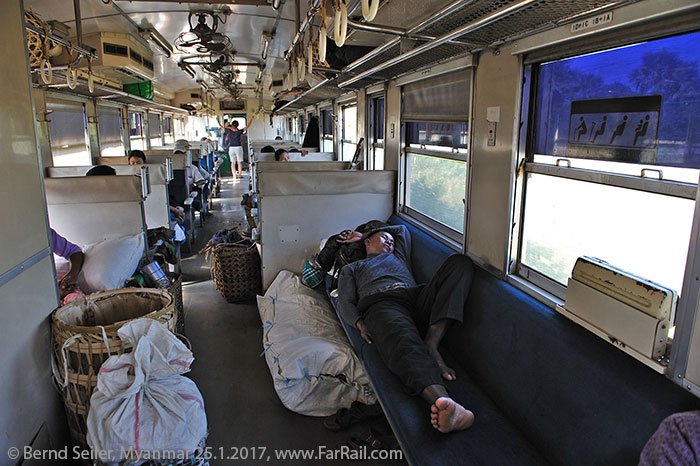
And so, back to my talks in the headquarters of the railways. Of course, we came up with several wishes for future tours. To my great surprise the mood seemed to be really relaxed after the tour went successfully without any problems. And so, they agreed to all suggestions and wishes. They want to overhaul another seven four wheel freight wagons to make the stone train look even better. With the six four wheel wagons we’ve paid for already added, it would make a 14 wagon train with the obligatory crew’s van. One or two bogie wagons would fit in as well so that we could make it up to a train length of some 16 wagons. Now, of course, they can see that a steam loco is easily able to haul such a load. This time, our stones reached a length of 13 wagons, which was not too bad as there aren’t many position where you see the whole length of the train but 16 would be even better … The overhaul of additional wagons will cost us money, that’s for sure, but I’m willing to split the costs of the investments over several tours, to keep the price within an affordable range. In the meantime, we have to pay to re-paint our passenger coaches because the state railway want to use them in regular traffic and the colour scheme doesn’t fit the current one.
While we were talking so frankly about opportunities, wishes and chances, I also mentioned different trains and places. They promised to check the opportunities with an open mind. Better to say, they promptly said “yes”! But I rate this as a soft answer and wait for a written confirmation before I’ll publish the next itinerary.
To get an appointment with the Deputy General Manager (Locomotives), we had to wait a long while, but it was worth it. Initially he had no time for us, only a couple of minutes, but during the meeting he called his next appointment and postponed the meeting for an uncertain time. Then finally he was listening to our proposals. And these sounded like: “The YD is the brother of the big sister, the YC. But the little sister, the YB is required to make the family complete. Why not overhaul a YB? Believe it or not, the Manager ordered other high ranked employees from his department to discuss the opportunity. He himself is a diesel man and has no idea about steam, but there are some in his department who know these locomotives from before 2008. From the once 50 classmates, not many have survived and of those only a very few are worth thinking about. YB 508 had its last overhaul in 2001, but it was out of use already by 2007, only YB 534 is complete and in a good state. YB 534 reached its plinth under its own steam. But it is the plinthed loco in front of the capital’s main station. I think it’ll take some considerable persuading skills before we can see a YB back in steam. But why shouldn’t it work? We persuaded them to convert YC 629 from coal to oil burning. We also planted this wish to have a YB back to life in another department (operation). Whether we’ll reap what we have sown will only tell in the future. It depends on many factors. But we cannot wait another nine years, even though the re-signalling of Bago station has already seen a delay of seven years, it’s unlikely that it’ll take another seven years before the gantries and semaphores fall. In the frameset of creating a museum in Bago we also mentioned these signals as an exhibit at the place where they stand now.
Conclusion:
Not only that the tour was extremely successful from the view point of a photographer, but there are also promising projects for the future. The next tour to
My special thanks go to all the railwaymen and -women who made it possible for steam to come back to life for a couple of days. And of course to our genius local guide. Without her, no wheel would have turned!
Back at home: Steam in Bago!

More pictures can found in the German trip report.
© FarRail Tours - e-mail: Bernd Seiler - zurück zu FarRail Tours
Click here to return to FarRail Tours